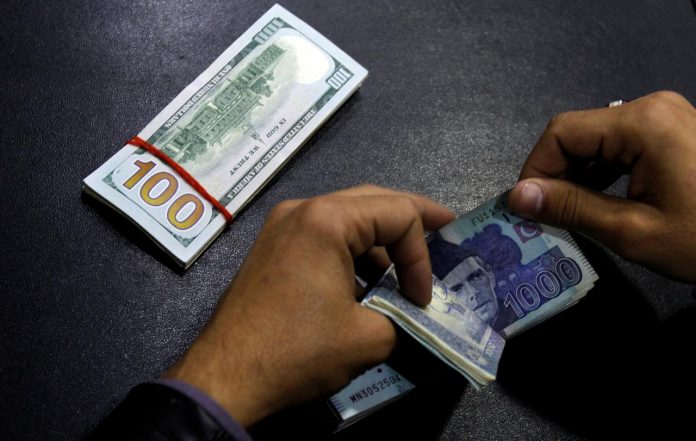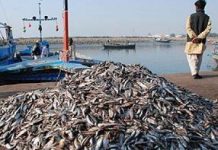
LAHORE: The rupee suffered another sharp devaluation in the interbank market on Friday, dropping to its lowest value ever against the US dollar at Rs144 before the State Bank intervened to raise its level to Rs136.50-137.50, as the finance minister claimed that devaluation ‘coupled with other policies’ will produce positive results for the ailing economy.
Due to volatility in intra-day trading, inter-bank rates tend to fluctuate in treasuries of different banks depending on their positions and closing rates of the rupee to a dollar were confirmed at Rs135.75-136.25 from one source, while another claimed their closing rate was Rs136.5-137.50.
Market sources attribute the sudden fall in the rupee to official commitments to the International Monetary Fund (IMF), though the government denies any such arrangement yet.
Addressing the press in a bid to soothe investor sentiment later in the day, Finance Minister Asad Umar once again stressed that setting the currency rate was the central bank’s responsibility.
He also blamed the current volatility on policies pursued by the Pakistan Muslim League-Nawaz (PML-N) government, saying the devaluation was inevitable because of ‘flawed policies’ of the previous administration.
Umar claimed that the devaluation was necessary because of several reasons, including increased foreign loans, decreased foreign exchange reserves, low exports and an artificial cap on the value of the dollar.
The finance minister said that rupee value cannot be controlled forever. “Even during the PML-N’s tenure, the value of rupee against the dollar had reduced by Rs28,” he said, adding that the government artificially increased the value of rupee by purchasing dollars.
“As a result, we started importing vegetables and we were unable to export surplus sugar and wheat without providing a subsidy,” he said.
“The issue of the dollar is associated with supply and demand,” he said, adding that the former government-subsidized foreign traders and taxed the locals. “The gap between supply and demand of dollar will remain until we address the issue of production and foreign investment.”
“We had two options; either to continue the old practice of artificially controlling the value of rupee [or to devalue the rupee],” the finance minister said.
While admitting that devaluation was “not a good thing” as it increases inflation, Umar concluded: “The devaluation coupled with other policies [being adopted by the PTI-led government] will produce positive results.”
Earlier, on Friday the rupee dipped to an intra-day low of Rs144 against the dollar in the inter-bank market, regaining Rs9 later on during trading to close between Rs136.5-137.50.
The rupee opened at Rs 140 bid and Rs145 offer rate on Friday morning and was trading at a Rs140-142.2 spread in the inter-bank market against the dollar.
Meanwhile, later during the day Pak rupee regained its position and was seen trading between Rs135 – Rs136 interbank against the dollar.
Moreover, the rupee was being bought at Rs137 in the kerb market and the currency dealers refused to sell dollars.
In a comment to Profit, Zeeshan Afzal analyst at Insight Securities said, “Trade of rupee near its justified value is the part of the solution. The complete solution is a suitable monetary policy and support of govt to improve Pakistan’s forex inflow.”
Meanwhile, the State Bank of Pakistan (SBP) on Friday increased the interest rate by 150 basis points to 10 per cent from the existing 8.5 per cent announced at the end of September.
Due to the latest depreciation of the local currency, the total debt owed by Pakistan has risen to Rs760 billion.
Speaking to Profit, Pak Kuwait Investment Co AVP Research Adnan Sheikh said, “In line with expectations, the rupee continues its three-monthly slide against the dollar and at this rate, we are on track for Rs160-170 by June next year.
“As per my previous prediction in July, the rupee would touch Rs160-70.”
“Inflation, bank interest rates and petrol prices will keep rising beyond market consensus and bank loans are going to bust.
“Albeit depreciation has taken place gradually, a cumulative slide of 34% from 105 is not a light matter. And things will start going bump in the dark, especially the banking sector which has seen a sharp rise in rates and will continue to see the same.
Banks will not benefit unless rates are stable for at least 3-6 months,” explained Mr Adnan.
“Also, the foreign exchange losses importers will face in this quarter will be unprecedented, as its the highest quarterly depreciating having adjusted from Rs123 to Rs133 in October and now to Rs140 in November making this quarter’s move around 13-14% alone, said Adnan.
According to analysts, this signals that the central bank has decided to let the rupee further depreciate against the dollar in line with IMF’s demand and to boost exports.
Since December last year, the currency has cumulatively depreciated by 36 per cent and had closed trading at Rs133.99 on Thursday in the inter-bank market.
According to a research note from Arif Habib Limited, “As we write, the Pak Rupee has once again portrayed a sharp weakness against the US Dollar, depicting the largest intraday swing of 8.21 per cent to ~145.00 in the interbank vis-à-vis last closing of 133.99.
However, we highlight that we put off any conclusions of settlement in the early hours of FOREX trading so as to identify by day end whether or not the parity has been adjusted by the State Bank of Pakistan (SBP).”
“Mounting pressure on foreign exchange reserves ($14.6bn at present, SBP reserves at $8.1 billion and import cover at a meagre 1.7 months), negative net international reserves at ~$10 billion (NIR – adjusting SBP reserves with forward foreign currency swaps and scheduled debt servicing for 1 year), alongside the infamous current account deficit (at $4.8 billion in 4MFY19; -4.6 per cent YoY) has persistently stressed the PKR-USD parity,” said the report.
Additionally, we also cite approaching International Monetary Fund (IMF) for a potential bailout package as a possible reason for depreciation of the Pak Rupee. To recall, last major movement in a single day was witnessed in Oct’18 whereby the PKR slipped against USD by 7.54 per cent DoD to settle at 133.64, due to concerns over the deteriorating external account,” it added.
This marks the sixth time since last December, that the central bank has allowed the rupee to depreciate against the greenback as inflationary pressure, rising fiscal and current account deficits alongside stagnant exports compelled it to take this move.
According to a Fitch Solutions report last week, Pakistan’s economic growth will slow down over the coming quarters and projected it to be 5.4 per cent for FY19 compared to 5.8 per cent in FY18.
Amongst the major demands of the IMF include increasing general sales tax (GST) to 18 per cent, further depreciation in the rupee and a tighter monetary policy.







Crucially badly rising $ in Pakistan. ..
Importer exporters are badly hurt by dollar rising
Asad Umar loosing trust of general public .
The depreciation of PKR is not the main problem here. The problem is how the govt is handling the situation in such a pathetic manner. This is breaking the confidence of investors, and once that happens, it will be unlike anything that has happened before.
Agree
Comments are closed.